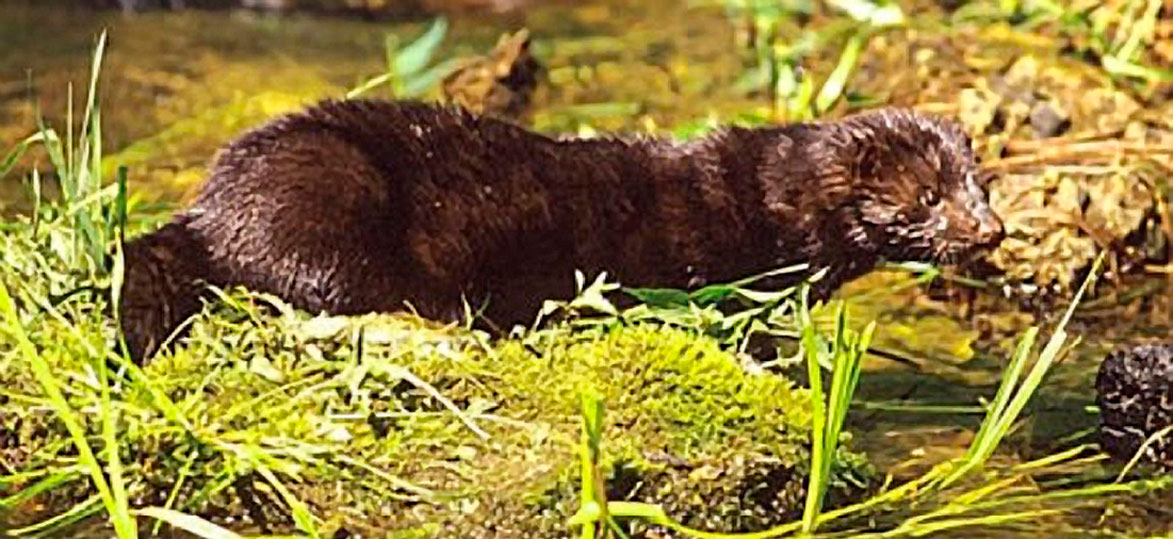
The mink (Neovison vison) is a highly prized furbearer. It is a member of the weasel family and is larger than both the long-tailed and short-tailed weasel. It is also one of the most aquatic members of the weasel family.
Habits and Habitat
Though water is the determining factor when establishing territories, mink are more often found in coniferous and mixed forests than in deciduous forests. They can be found along streams, rivers, lakes, and marshes.
Any areas with a permanent water source are potential mink habitat. Wetlands that have abundant vegetation along the shoreline are also important, as well as those that have irregular shorelines, as they offer more cover and protection than if it were open and exposed.
Mink live in burrows which they may excavate themselves, or they may use abandoned dens of another animal, such as muskrat dens or beaver lodges. These dens are commonly found along streams or the banks of ponds. Mink often line the interior of their home with leaves and grass as well as fur from prey that has been consumed.
Mink are mainly nocturnal (active at night) but can be seen any time of day. They are solitary creatures, except when rearing kits, and are considered to be more aggressive than sociable. It is not uncommon for male mink to fight, especially during mating season.
Mink are territorial animals and mark ranges with a scent to warn other minks to stay away. They will challenge other mink and other species as well.
Reproduction
One female will likely find many suitors during the breeding season, which occurs from late February to early April. After mating, the fertilized egg remains in limbo through a process known as delayed implantation. During this period, all development of the embryo ceases for approximately seven to 30 days. After this time, the fertilized egg is implanted into the uterus wall and development of the embryo begins. A total gestation period of 51 days is average, but it can range from 40 to 75 days.
The litter is born from April to May and may vary in size from two to ten young but is typically six or seven. The kits are born with eyes closed, little body hair and completely dependent on the female for survival. The young develop quickly—their first teeth emerge at two weeks, eyes open around four weeks, and they are soon weaned from their mother's milk.
By seven weeks of age, the kits are roughly half of their adult size. They will stay with the mother through the summer and in the fall, leave to establish their own territories.
The females attain adult weight at four months and reach sexual maturity by 12 months of age. The males do not attain adult weight until nine to 11 months and reach sexual maturity by 18 months of age.
Mink give birth and raise only one litter a year. Mink are extremely prolific and are able to replace their population entirely over a three-year time period.
Diet
Mink are aggressive carnivores seeking out prey on land and in the water. They eat muskrats, rabbits, small rodents, waterfowl, marsh-nesting birds, crayfish, aquatic beetles, and fish. Mink swim well because of their partially webbed feet, which allow them to feed in and along rivers, streams, lakes and ponds. They are also a capable predator on land, quick and agile, and an excellent tree climber.
The mink's diet varies with the season, habitat and prey availability. In summer, much of its diet consists of small mammals, frogs, rodents, fish, and waterfowl. In winter, the mink relies more on small mammals and will sometimes kill more than they need to stock food in their dens
The mink is an opportunistic hunter and a fierce predator that often attacks animals larger than itself, such as rabbits and waterfowl. Its underwater vision is poor so it will often locate the animal above the surface before diving in to retrieve it. On land, the mink relies on its sense of smell. The mink commonly stalks its prey by slinking along the ground. It will also frighten and then chase down its prey.
Management
The mink is a common species. In Vermont, its population is protected through a highly regulated trapping season that occurs in the fall. Another important management tool is to protect their preferred habitat. The best habitat management practice for mink is to restore wetlands and protect existing wetlands and buffer areas along streams and rivers.
Status
Mink are highly adaptable and tolerant of human activity. They are abundant in Vermont and well distributed. However, mink are susceptible to toxins in the water such as mercury because they are at the top of the food chain. Maintaining clean water is important to mink survival and reproduction.
